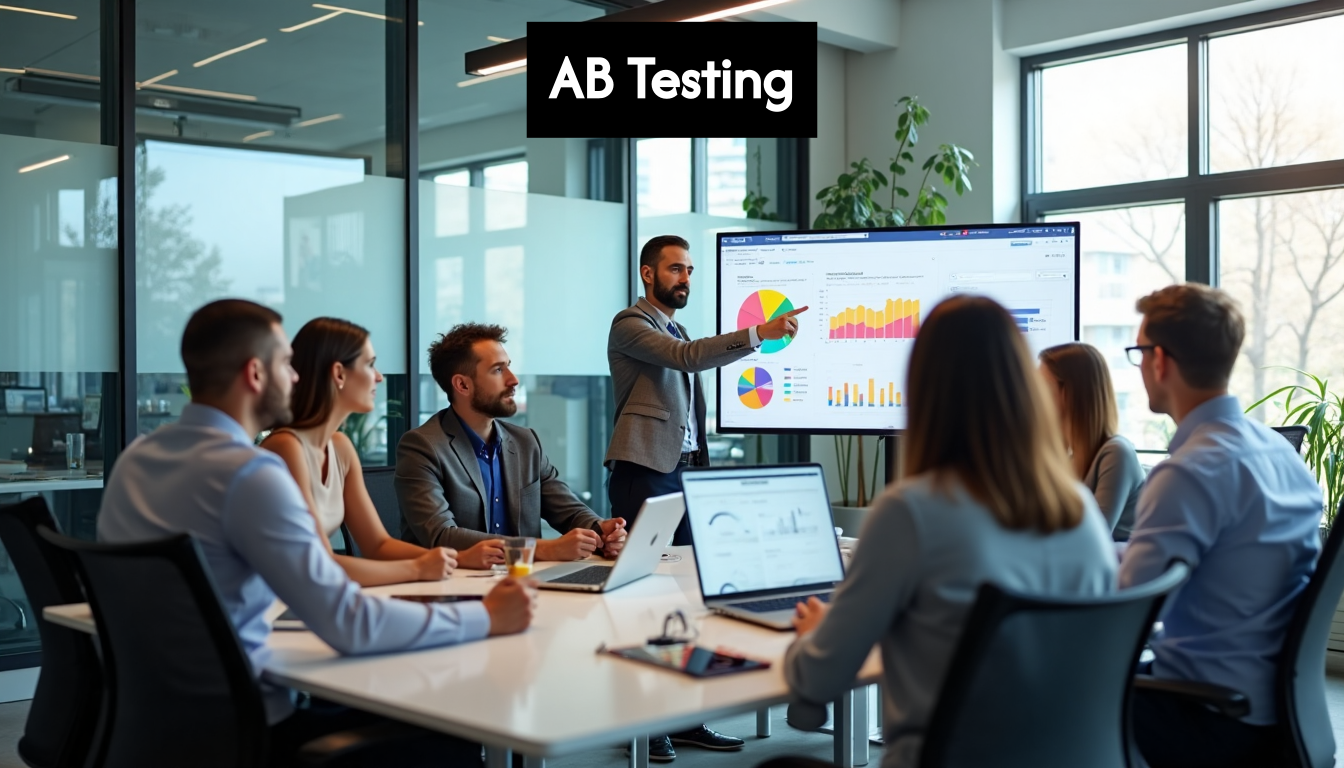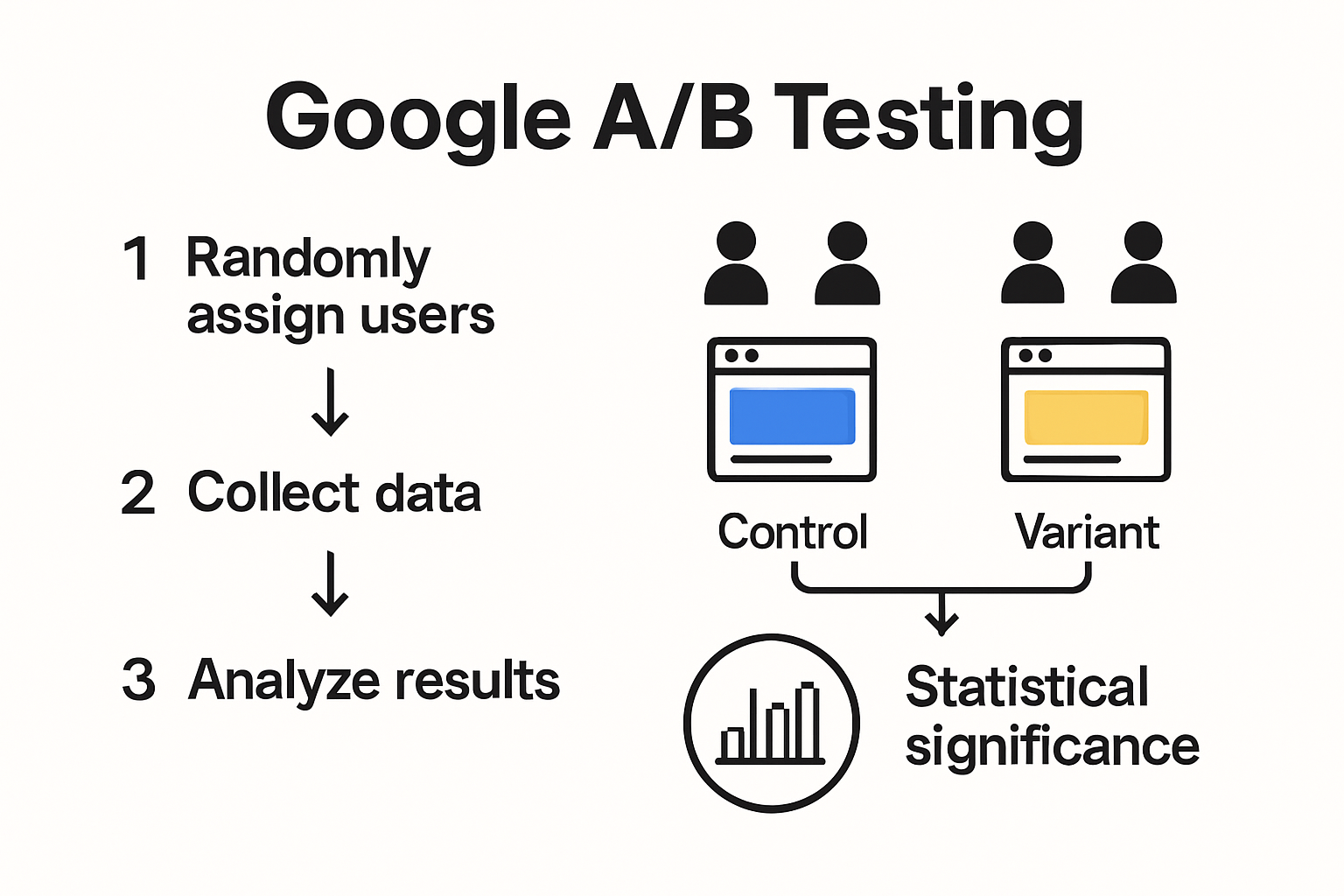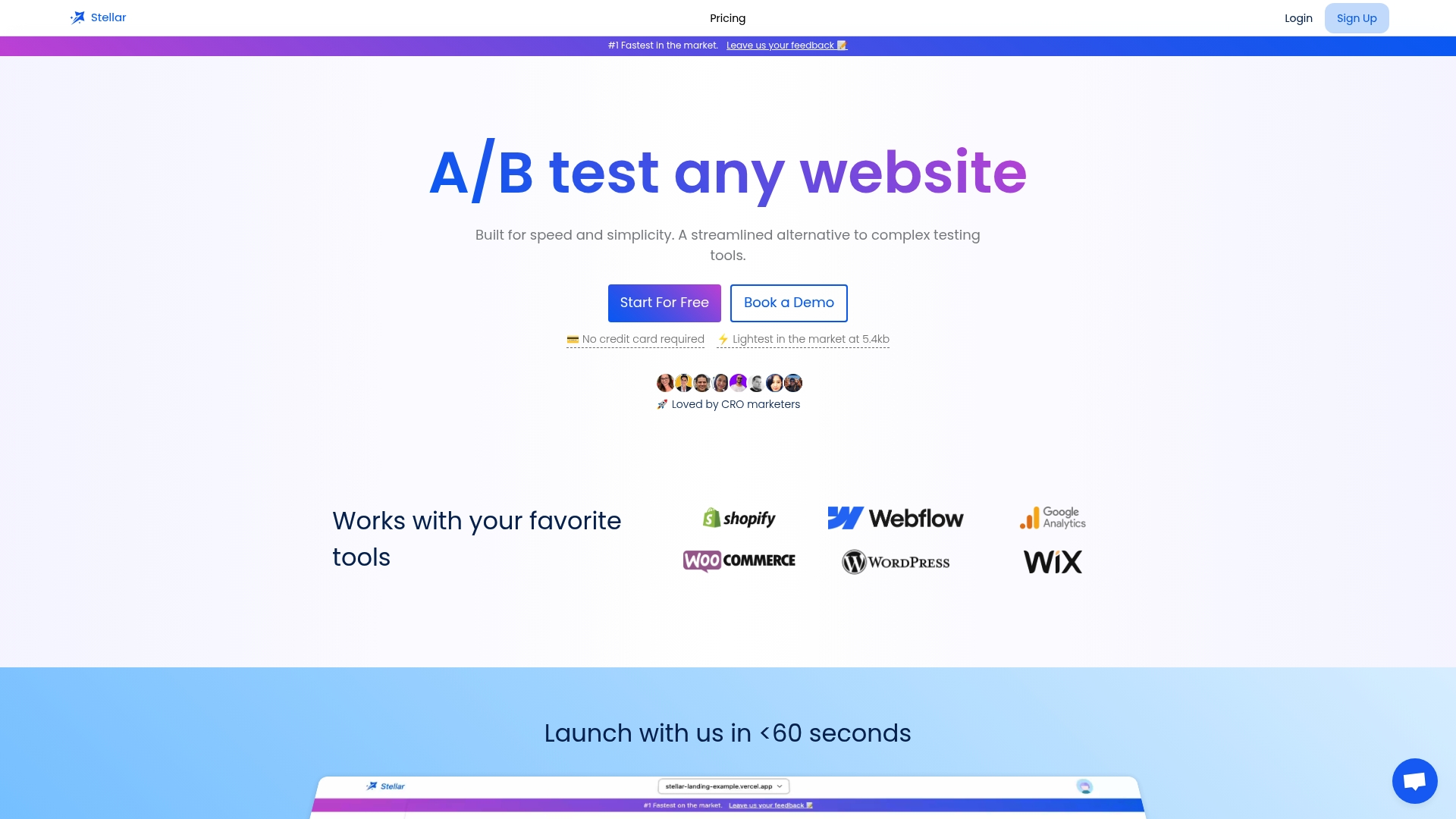
Google AB Testing: Strategies for Higher Conversions in 2025

Google AB testing is changing the way businesses increase conversions. The newest tools now offer AI-driven optimization and real time analytics, letting marketers see results almost instantly. Sounds high tech, right? Many still assume running these sophisticated experiments requires big budgets and IT teams. The truth is, some platforms democratize the process to the point where even small teams can launch advanced tests. Over 95 percent of professional marketers seek results that reach statistical confidence before making any decision. This level of precision was out of reach just a few years ago, but it is shaping digital marketing’s next big leap.
Table of Contents
- How Google Ab Testing Works Today
- Best Practices For Effective Ab Experiments
- Top Tools And Alternatives For Google Ab Testing
- Interpreting Results To Drive Business Growth
Quick Summary
| Takeaway | Explanation |
|---|---|
| Establish Robust Experimental Parameters | Ensure significant sample sizes, appropriate test durations, and focus on isolating variables to accurately assess performance drivers in AB tests. |
| Avoid Common Experimental Pitfalls | Be wary of insufficient statistical power and premature test termination to maintain the integrity of the experiments and avoid misleading results. |
| Leverage Advanced AB Testing Tools | Utilize modern AB testing platforms that offer AI-driven optimization and real-time analytics to enhance experimentation and derive clearer insights. |
| Decode Statistical Significance | Understand and apply statistical principles, like confidence intervals and sample sizes, to ensure the validity and relevance of AB testing results. |
| Translate Metrics into Strategic Insights | Connect experimental results to broader business objectives, identifying performance bottlenecks and quantifying potential impacts to drive organizational growth. |
How Google AB Testing Works Today
Google AB testing represents a sophisticated approach to understanding web performance and user interactions through systematic experimentation. Modern AB testing techniques have evolved dramatically, moving beyond simple webpage variations to complex, data-driven methodologies that deliver precise insights for digital marketers.
Understanding Google's Core Testing Framework
At its core, Google AB testing focuses on comparing two versions of a webpage or digital asset to determine which performs better according to specific metrics. Unlike traditional testing methods, Google's approach integrates advanced statistical modeling and machine learning algorithms to provide nuanced performance evaluations. Learn more about advanced testing strategies reveals that the process involves carefully controlled experiments where variables are systematically manipulated to understand user behavior.
The technical infrastructure supporting Google AB testing relies on sophisticated randomization techniques. When a user visits a webpage, they are randomly assigned to either the control group (original version) or the variant group. This randomization ensures statistically valid results by minimizing potential bias. According to research from SearchPilot, the key difference in SEO-focused AB testing is that pages are split into groups rather than individual users, which helps maintain search engine optimization integrity.

Advanced Segmentation and Real Time Analysis
Modern Google AB testing transcends simple binary comparisons. Contemporary techniques involve granular audience segmentation, allowing marketers to test variations across different user demographics, device types, and behavioral patterns. Kameleoon's research highlights that effective testing in 2025 will emphasize triggered experiments based on specific user behaviors such as page views, session duration, and custom API events.
The technological sophistication of current AB testing platforms enables near instantaneous data collection and analysis. Marketers can now observe how different page elements impact user engagement within minutes of launching a test. This real time feedback loop allows for rapid iteration and optimization, transforming AB testing from a periodic activity to a continuous improvement process.
Precision and Statistical Significance
Achieving meaningful results in Google AB testing requires understanding statistical significance. Modern tools automatically calculate confidence levels, ensuring that observed differences are not merely random fluctuations. Professional marketers look for test results with a confidence level of at least 95%, which indicates that the observed variation is likely to represent a genuine performance difference.
Advanced AB testing platforms now integrate machine learning algorithms that can predict potential outcomes and recommend optimal testing strategies. These intelligent systems analyze historical data, user behavior patterns, and contextual factors to suggest the most promising experimental approaches. By leveraging such technologies, marketers can move beyond guesswork and make data driven decisions that genuinely improve digital experiences.
Understanding and implementing Google AB testing effectively requires a strategic approach that combines technical expertise, statistical knowledge, and creative problem solving. As digital landscapes become increasingly complex, mastering these testing methodologies will be crucial for organizations seeking to optimize their online presence and drive meaningful user engagement.
Best Practices for Effective AB Experiments
Designing and executing successful AB experiments requires a strategic approach that balances technical precision with marketing insight. Digital marketers must navigate complex testing environments while maintaining experimental integrity and driving meaningful performance improvements.
Establishing Robust Experimental Parameters
Successful AB testing begins with meticulous experimental design. Explore advanced testing strategies to understand how precise parameter selection can dramatically impact results. According to Google's recommended testing guidelines, marketers must implement canonical tags to prevent potential search engine indexing complications during experiments.
Critical parameters for effective AB experiments include:
- Sample Size: Ensure statistically significant participant numbers
- Test Duration: Run experiments long enough to capture meaningful variations
- Isolated Variables: Test only one element at a time to understand precise performance drivers
Professional marketers recognize that testing complexity increases with each additional variable. Agency Analytics research emphasizes the importance of isolating single elements like headlines, call-to-action buttons, or visual design components to generate clear insights.
Avoiding Common Experimental Pitfalls
Navigating AB testing requires understanding potential technical and methodological challenges. Google explicitly warns against cloaking test pages, which involves showing different content to search engines versus users. This practice violates search engine guidelines and can result in significant penalties, including potential site removal from search indexes.
Key pitfalls to avoid include:
- Insufficient statistical power
- Premature test termination
- Overlooking contextual variations
- Ignoring user segment differences
Advanced testing platforms now integrate machine learning algorithms that can help predict potential experimental outcomes and recommend optimal testing strategies. These intelligent systems analyze historical performance data, user behavior patterns, and contextual factors to suggest the most promising experimental approaches.

Interpreting and Implementing Test Results
Translating AB experiment data into actionable insights requires sophisticated analytical skills. Professional marketers seek test results with a minimum 95% confidence level, indicating that observed variations represent genuine performance differences rather than random statistical noise.
Successful implementation involves:
- Comprehensive result verification
- Cross-referencing multiple performance metrics
- Understanding nuanced user interaction patterns
- Developing iterative optimization strategies
The most effective AB testing approaches view experiments not as isolated events but as part of a continuous improvement cycle. Each test provides incremental learning, enabling marketers to progressively refine digital experiences and enhance user engagement.
Ultimately, mastering AB experiments demands a holistic approach that combines technical expertise, statistical knowledge, and creative problem solving. As digital marketing landscapes become increasingly complex, organizations that develop robust testing methodologies will gain significant competitive advantages in understanding and responding to user behaviors.
Top Tools and Alternatives for Google AB Testing
The landscape of AB testing tools has undergone significant transformation in 2025, with innovative platforms emerging to fill the gap left by Google Optimize's discontinuation. Digital marketers now have access to sophisticated tools that offer advanced targeting, real-time analytics, and intelligent optimization capabilities.
Advanced AB Testing Platforms
Leading AB testing solutions have evolved to provide comprehensive experimentation environments. Discover powerful testing strategies that leverage cutting-edge technologies. According to Coursera's technology report, top platforms like LaunchDarkly, Convertize, and Zoho PageSense now offer sophisticated features that go beyond traditional testing methodologies.
Key characteristics of modern AB testing tools include:
- AI-Driven Optimization: Intelligent algorithms that automatically allocate traffic and predict test outcomes
- Comprehensive Integration: Seamless connections with analytics platforms and marketing ecosystems
- Advanced Targeting: Granular user segmentation based on demographics, behavior, and custom parameters
CXL's comprehensive analysis highlights the importance of tools that provide visual editors, real-time analytics, and multi-platform support. These platforms enable marketers to create complex experiments with minimal technical overhead, democratizing advanced testing capabilities.
Emerging Technologies in Experimentation
The next generation of AB testing tools leverages artificial intelligence and machine learning to transform experimental approaches. Convertize's research reveals that multi-armed bandit algorithms are replacing traditional statistical methods, allowing for more dynamic and adaptive testing strategies.
Notable technological innovations include:
- Predictive performance modeling
- Automated variant generation
- Real-time experiment optimization
- Cross-channel experimentation capabilities
These advanced platforms go beyond simple A/B comparisons, offering intelligent systems that can simultaneously test multiple variations and automatically allocate traffic to the most promising versions. Machine learning algorithms analyze user interactions, predicting potential outcomes with unprecedented accuracy.
Selecting the Right AB Testing Solution
Choosing an appropriate AB testing tool requires careful consideration of specific organizational needs. Professional marketers should evaluate platforms based on several critical factors:
- Complexity of testing requirements
- Budget constraints
- Technical infrastructure
- Desired level of customization
- Integration capabilities
The most effective tools in 2025 provide a balance between user-friendly interfaces and advanced experimental capabilities. They offer visual editors that allow non-technical team members to design complex tests while providing deep analytical insights for data scientists and marketing strategists.
As the digital marketing landscape continues to evolve, organizations must remain agile in their approach to experimentation. The most successful teams will leverage tools that not only provide robust testing capabilities but also offer intelligent insights that drive meaningful business improvements. Selecting the right AB testing platform is no longer just about comparing variations it is about creating a comprehensive optimization strategy that adapts to changing user behaviors and market dynamics.
Interpreting Results to Drive Business Growth
Successful AB testing transcends mere data collection. The true power lies in transforming experimental insights into strategic business growth initiatives that drive meaningful organizational improvements. Professional marketers must develop sophisticated approaches to result interpretation that go beyond surface-level metrics.
Decoding Statistical Significance
Learn advanced data interpretation techniques to unlock hidden performance insights. Understanding statistical significance represents the foundational skill for meaningful result analysis. According to Google's recommended testing guidelines, marketers must implement rigorous verification processes to ensure experimental validity.
Key statistical considerations include:
- Confidence Intervals: Determining reliable result ranges
- Sample Size: Ensuring representative data collection
- Margin of Error: Quantifying potential experimental variations
Professional analysts recognize that raw numbers require contextual interpretation. A statistically significant result does not automatically guarantee business value. Marketers must connect experimental outcomes to broader strategic objectives, understanding how incremental improvements translate into tangible financial gains.
Translating Metrics into Strategic Insights
Advanced result interpretation involves mapping experimental data against comprehensive business key performance indicators. Sixth City Marketing research highlights the critical importance of connecting conversion metrics to specific business growth strategies.
Strategic translation requires:
- Identifying performance bottlenecks
- Quantifying potential revenue impact
- Understanding user behavior patterns
- Developing targeted optimization strategies
Machine learning algorithms now enable more sophisticated result analysis, providing predictive modeling that goes beyond traditional statistical methods. These intelligent systems can project potential long-term impacts of seemingly minor experimental variations, allowing businesses to make more informed strategic decisions.
Scaling Successful Experimental Outcomes
The ultimate goal of AB testing is not just measurement but transformative business improvement. YouTube's marketing insights emphasize the importance of developing scalable strategies based on experimental results.
Effective scaling involves:
- Identifying universally applicable insights
- Developing repeatable optimization frameworks
- Creating cross-channel implementation strategies
- Establishing continuous improvement protocols
Successful organizations treat AB testing as an ongoing dialogue with their users, continuously refining their understanding of customer preferences and behaviors. The most advanced teams view experimental results not as static data points but as dynamic insights that inform broader strategic planning.
As digital marketing landscapes become increasingly complex, the ability to extract meaningful insights from AB testing will separate high-performing organizations from their competitors. The most successful businesses will develop adaptive strategies that leverage experimental data to create more personalized, responsive user experiences. Interpreting results is no longer just about understanding what happened it is about predicting and shaping future business performance.
Frequently Asked Questions
What is Google AB Testing?
Google AB Testing is a method used to compare two versions of a webpage or digital asset to determine which one performs better in terms of specific metrics by systematically manipulating variables.
How can I improve conversion rates using Google AB Testing?
You can improve conversion rates by using advanced segmentation, establishing robust experimental parameters, and leveraging AI-driven tools to optimize experiments and gain precise insights.
What are the best practices for executing an effective AB test?
Best practices include ensuring statistically significant sample sizes, running tests for adequate durations, isolating variables, and avoiding common pitfalls like premature test termination and insufficient statistical power.
How do I interpret the results of my AB tests?
Interpreting results involves understanding statistical significance, translating metrics into strategic insights, and scaling successful outcomes by identifying performance bottlenecks and developing targeted optimization strategies.
Ready to Transform Your AB Testing Results?
If you are tired of running tests where results take weeks to reach statistical significance or you worry that bulky scripts are slowing down your site, you are not alone. As this article showed, modern AB testing success hinges on speed, ease of use, and real-time analytics. Small teams especially need tools that deliver robust experimentation without complex setup or coding headaches.

Now is the perfect moment to unlock higher conversions with a lightweight and truly fast solution. Stellar delivers everything mentioned in this guide and more. Experience a no-code visual editor, advanced goal tracking, and instant analytics—all with a script size of just 5.4KB. Why wait for results or get bogged down by complicated software?
Start your free plan today at Stellar, and empower your marketing team to launch smarter AB tests in minutes. See what seamless experimentation and real conversion growth really feel like.
Recommended Articles
Published: 6/16/2025
